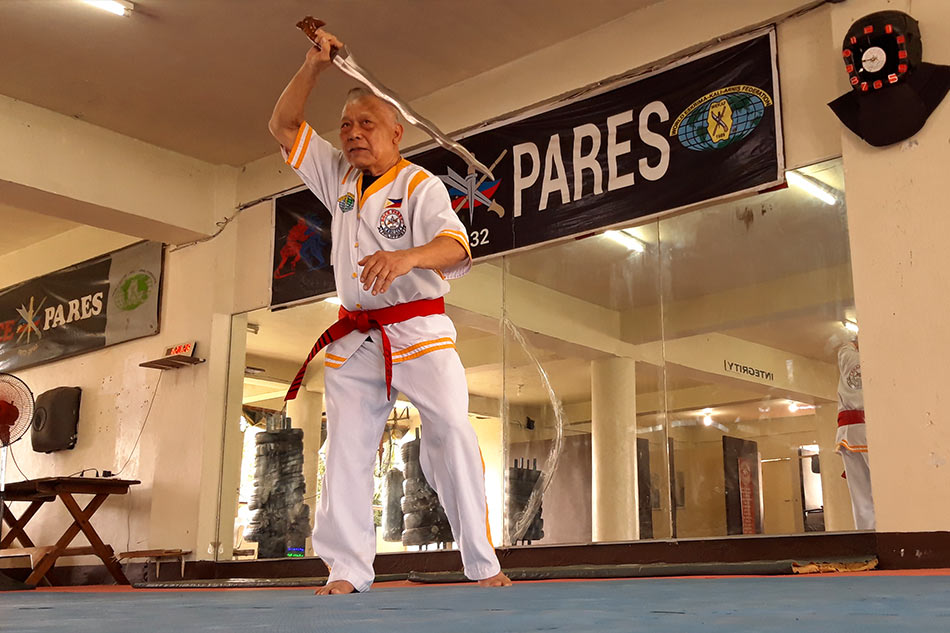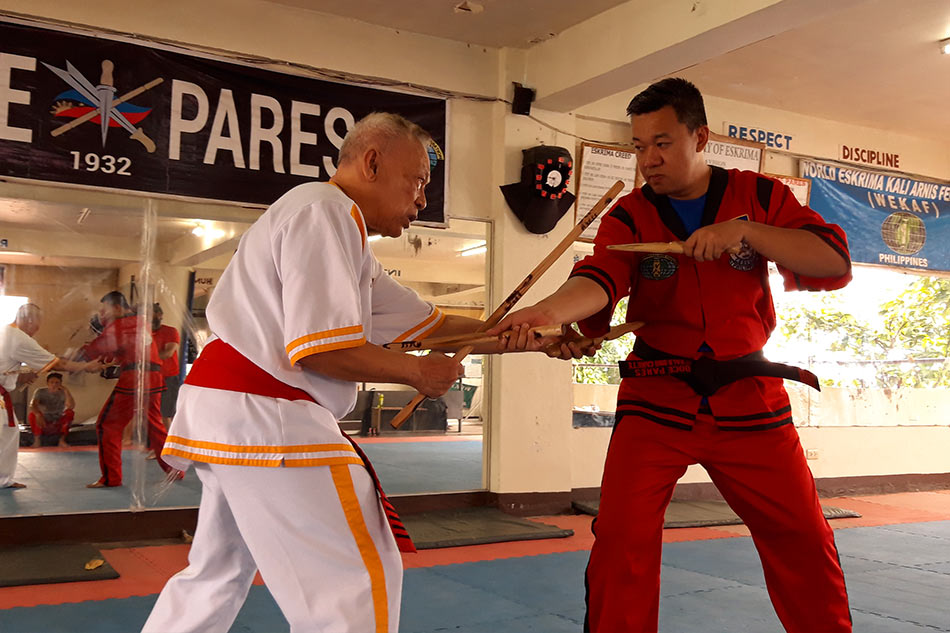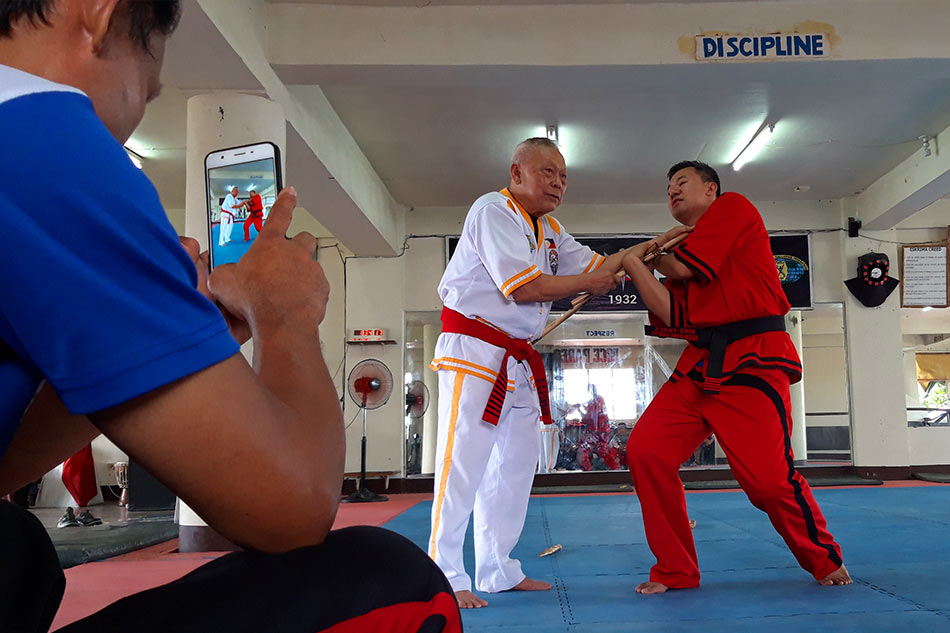#SEAGames2019: A look at the rich history of arnis | ABS-CBN
Sports
#SEAGames2019: A look at the rich history of arnis
#SEAGames2019: A look at the rich history of arnis
Dennis Gasgonia,
ABS-CBN News
Published Nov 30, 2019 02:51 AM PHT
|
Updated Nov 30, 2019 02:20 PM PHT
Arnis, the Filipino martial art primarily involving the use of rattan sticks, may be as old as the Philippines, if not older.
Also known as escrima or kali, arnis is commonly perceived as a just a stickfighting art. However, it is a complete fighting system that also covers knife fighting and hand-to-hand combat.
Arnis, the Filipino martial art primarily involving the use of rattan sticks, may be as old as the Philippines, if not older.
Also known as escrima or kali, arnis is commonly perceived as a just a stickfighting art. However, it is a complete fighting system that also covers knife fighting and hand-to-hand combat.
Supreme Grandmaster Dionisio “Diony” Cañete, founder of World Eskrima Kali Arnis Federation (WEKAF), the world sanctioning body for the sport, the martial art may be traced back to pre-Spanish colonial times.
Supreme Grandmaster Dionisio “Diony” Cañete, founder of World Eskrima Kali Arnis Federation (WEKAF), the world sanctioning body for the sport, the martial art may be traced back to pre-Spanish colonial times.
“Long before Lapu Lapu, mayroon na tayong Philippine martial arts as per revelations of Indo-Malay traders, Chinese traders, they came to the Philippines, to Cebu and saw Filipinos practicing martial arts,” Cañete said.
“Long before Lapu Lapu, mayroon na tayong Philippine martial arts as per revelations of Indo-Malay traders, Chinese traders, they came to the Philippines, to Cebu and saw Filipinos practicing martial arts,” Cañete said.
“But recorded history could not be found. Because when the Spaniards came to the Philippines, they burned the records.”
“But recorded history could not be found. Because when the Spaniards came to the Philippines, they burned the records.”
ADVERTISEMENT
When the Spaniards landed, they banned the practice of kali.
When the Spaniards landed, they banned the practice of kali.
“Ang rason nila is the Filipinos were spending more time performing, practicing the martial arts, and forgetting their work in the fields. But actually, the Spaniards feared it would be used against them,” Cañete said.
“Ang rason nila is the Filipinos were spending more time performing, practicing the martial arts, and forgetting their work in the fields. But actually, the Spaniards feared it would be used against them,” Cañete said.
“So in order to circumvent the prohibition, the Filipinos went to practice the arts using sticks. That's why they practiced the ‘kali dance,’ in order to defy and avoid being caught by the Spaniards, the Filipinos used sticks, instead.”
“So in order to circumvent the prohibition, the Filipinos went to practice the arts using sticks. That's why they practiced the ‘kali dance,’ in order to defy and avoid being caught by the Spaniards, the Filipinos used sticks, instead.”
Although the art was practiced by various pre-Hispanic Filipino tribes, contemporary arnis was said to have carried influence from various settlers and traders travelling through the Malay Archipelago.
Although the art was practiced by various pre-Hispanic Filipino tribes, contemporary arnis was said to have carried influence from various settlers and traders travelling through the Malay Archipelago.
The fighting art also carried concepts used in old fencing that originated in Spain in the 15th century. Hence, some of the arnis terminologies were in Spanish, including oramis heneral, tirada, ocho, ekis, and espada y daga.
The fighting art also carried concepts used in old fencing that originated in Spain in the 15th century. Hence, some of the arnis terminologies were in Spanish, including oramis heneral, tirada, ocho, ekis, and espada y daga.
It has numerous versions depending on locality as it was practiced in various provinces including Cebu, Ilocos, Pampanga, Iloilo, and different areas of Mindanao.
It has numerous versions depending on locality as it was practiced in various provinces including Cebu, Ilocos, Pampanga, Iloilo, and different areas of Mindanao.
Modern era
When the Americans came in the 1900s, Cañete’s father, Eulogio, and uncle Cacoy took up the arts, training under revered “escrimadors.”
When the Americans came in the 1900s, Cañete’s father, Eulogio, and uncle Cacoy took up the arts, training under revered “escrimadors.”
“Father ko nag-arnis, uncle ng father ko did arnis. In 1918, they moved to the city, met the top eskrimadors at the time, the Saavedra family. Lorenzo and Teodoro, they were the foremost noon. They formed the Labangon Fencing Club. That was the first arnis club in the Philippines,” said Cañete.
“Father ko nag-arnis, uncle ng father ko did arnis. In 1918, they moved to the city, met the top eskrimadors at the time, the Saavedra family. Lorenzo and Teodoro, they were the foremost noon. They formed the Labangon Fencing Club. That was the first arnis club in the Philippines,” said Cañete.
Years later, the fencing club was dissolved due to politics. Eulogio later reorganized the group composed of 12 founders with different arnis styles and called it “Doce Pares.”
Years later, the fencing club was dissolved due to politics. Eulogio later reorganized the group composed of 12 founders with different arnis styles and called it “Doce Pares.”
“The basis of the name Doce Pares was the 12 bodyguards-swordsmen of Emperor Charlamagne of France. They killed hundreds with the use of sword fighting in 800 AD,” Cañete said.
“The basis of the name Doce Pares was the 12 bodyguards-swordsmen of Emperor Charlamagne of France. They killed hundreds with the use of sword fighting in 800 AD,” Cañete said.
He added that he picked up the martial arts during the war. He and his brother were able to learn the various styles.
"My father taught his style, my uncle (Cacoy) taught his style, so me and my brothers learned every style . . . That's why we became exceptional kasi we could teach every style," he said.
He added that he picked up the martial arts during the war. He and his brother were able to learn the various styles.
"My father taught his style, my uncle (Cacoy) taught his style, so me and my brothers learned every style . . . That's why we became exceptional kasi we could teach every style," he said.
Just like Charlamange’s men, some of the escrima grandmasters were employed by local politicians as bodyguards. Others engaged in “Juego Todos,” or all-out street brawls, wherein they challenge each other to test who the better escrimador was.
Just like Charlamange’s men, some of the escrima grandmasters were employed by local politicians as bodyguards. Others engaged in “Juego Todos,” or all-out street brawls, wherein they challenge each other to test who the better escrimador was.
“There were too much intrigues among masters. In 1952, after elections, some grandmasters were shot. Five months later, the group headed by Anciong Bacon left and formed the Balintawak Arnis. In 1960, another group put up Lapunti Arnis. But they all came from us,” Cañete said.
“Prevalent ang Juego Todo noon, especially when Balintawak left there have been grandmasters fighting without any head gear. Naging regular occurrence. Sometimes they fight with 1-meter rope. I grew up watching these fights.”
“There were too much intrigues among masters. In 1952, after elections, some grandmasters were shot. Five months later, the group headed by Anciong Bacon left and formed the Balintawak Arnis. In 1960, another group put up Lapunti Arnis. But they all came from us,” Cañete said.
“Prevalent ang Juego Todo noon, especially when Balintawak left there have been grandmasters fighting without any head gear. Naging regular occurrence. Sometimes they fight with 1-meter rope. I grew up watching these fights.”
Civilizing the art
Cañete later became a lawyer. As one of those who were privileged with education, he was invited to become a member of the Doce Pares board in the 1970s. He obliged only if given the power to introduce changes in their system to preserve the art.
Cañete later became a lawyer. As one of those who were privileged with education, he was invited to become a member of the Doce Pares board in the 1970s. He obliged only if given the power to introduce changes in their system to preserve the art.
One of the policies they enforced is to open the martial art to others: “Dati masyado kasing secretive, and the art was limited to close relatives lang.”
One of the policies they enforced is to open the martial art to others: “Dati masyado kasing secretive, and the art was limited to close relatives lang.”
They also did away with the deadly Juego Todos.
They also did away with the deadly Juego Todos.
“I said this art will never improve if we fight against each other. Sinong parientes ang papayag sa mga anak to participate in killings? Hindi tayo lalago kapag wala tayong kontrol,” Cañete said.
“I said this art will never improve if we fight against each other. Sinong parientes ang papayag sa mga anak to participate in killings? Hindi tayo lalago kapag wala tayong kontrol,” Cañete said.
Since then, they began formalizing rules for arnis competitions to replace the Juego Todos.
Since then, they began formalizing rules for arnis competitions to replace the Juego Todos.
They also introduced the use of full-body armor for tournament sparring aside from coming out with a rule book and guidelines that formalized and professionalized arnis as a sport.
They also introduced the use of full-body armor for tournament sparring aside from coming out with a rule book and guidelines that formalized and professionalized arnis as a sport.
They even held demonstrations abroad to promote the art. One of those who witnessed the exhibitions was Bruce Lee's training partner, Fil-American martial artist Dan Inosanto, who in turn also promoted the art.
They even held demonstrations abroad to promote the art. One of those who witnessed the exhibitions was Bruce Lee's training partner, Fil-American martial artist Dan Inosanto, who in turn also promoted the art.
In 1987, Cañete founded the World Eskrima Kali Arnis Federation (WEKAF), which became the world governing body for the sport. WEKAF boasts of more than 40-member countries and has held tournaments abroad.
In 1987, Cañete founded the World Eskrima Kali Arnis Federation (WEKAF), which became the world governing body for the sport. WEKAF boasts of more than 40-member countries and has held tournaments abroad.
The Filipino martial art became popular in Hollywood that it was seen being utilized in action flicks such as the Bourne series, “James Bond: Quantum of Solace,” “The Equalizer” and “The Book of Eli.”
The Filipino martial art became popular in Hollywood that it was seen being utilized in action flicks such as the Bourne series, “James Bond: Quantum of Solace,” “The Equalizer” and “The Book of Eli.”
In 2010, the Philippines officially adopted arnis as its national martial art and sport.
In 2010, the Philippines officially adopted arnis as its national martial art and sport.
The sport will make its second appearance in the Southeast Asian Games this year after making its initial foray into the Games back in 2005.
The sport will make its second appearance in the Southeast Asian Games this year after making its initial foray into the Games back in 2005.
This time, it will be spearheaded by the recently formed Philippine Escrima Kali Arnis Federation (PEKAF), headed by arnis practitioner, Senator Miguel Zubiri.
This time, it will be spearheaded by the recently formed Philippine Escrima Kali Arnis Federation (PEKAF), headed by arnis practitioner, Senator Miguel Zubiri.
For more sports coverage, visit the ABS-CBN Sports website.
For more sports coverage, visit the ABS-CBN Sports website.
Read More:
arnis
kali
Southeast Asian Games
SEA Games
2019 SEA Games
30th SEA Games
Philippine SEA Games
PH SEA Games
eskrima
WEKAF
ADVERTISEMENT
ADVERTISEMENT



